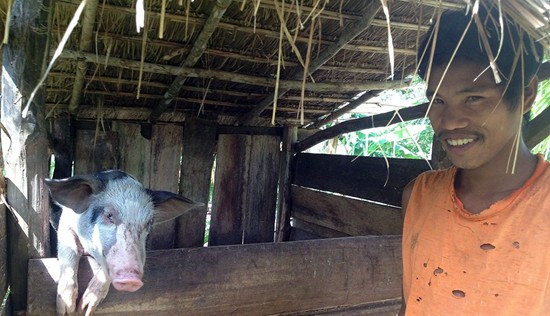|

SJDB
livestock training: "We discovered a lot of ways to take good
care of our swine especially when they are infected with
diseases or when they are pregnant or lactating," says a
beneficiary from Barangay Hagbay in San Jose de Buan, Samar. (By
NC-ND / ICRC / R. Calera) |
Improving lives in
conflict-affected communities
By
ICRC
October 30, 2015
MANILA – In parts of Luzon and the Visayas, communities suffer from
the effects of a protracted armed conflict between government security
forces and the New People’s Army. Often living in remote and far-flung
areas, these communities also struggle with poverty, making everyday
life a challenge for them.
“Economic growth is often stunted in these communities, which also
suffer from the insecurity caused by sporadic clashes. Because of
this, they have limited access to income opportunities and, at times,
basic services too,” said Oualid Bech, head of the ICRC subdelegation
in Luzon and the Visayas.
As support to people suffering from the chronic effects of conflict
and poverty, the ICRC carries out programs that aim to help the most
vulnerable barangays (villages) and communities stand on their own
feet and become more resilient.
These programs employ a participatory approach wherein the
beneficiaries identify their own needs. A series of consultations and
discussions with the ICRC is therefore held to determine what kind
projects are suitable, and how to effectively implement and sustain
them.
All projects are monitored and evaluated through field visits by ICRC
staff with the support of volunteers from the Philippine Red Cross,
the ICRC’s primary partner in the country.
Creating opportunities
In the mountainous area of Guihulngan in Negros Oriental province,
corn is the staple food and main source of livelihood of the
communities. The farmers, however, had to travel to a distant town to
have their corn milled, spending considerable effort and money.
The farming community identified this as a challenge, and when the
ICRC stepped in to support, they proposed building a corn-milling
facility. In March, the corn mill began operating, and it has already
benefited farmers from seven barangays and improved the quality of
milling.
It has also opened up business and employment opportunities, as the
local association earns from every milling session and uses the income
to employ people to maintain the corn mill.
The association has earned over P65,000 since March 2015. The project
has also encouraged small farmers to utilize portions of their lots
for corn farming.
“When we heard that a corn mill would be built in our barangay, we
(residents) were very happy. Manual grinding is insufficient and
cannot accommodate us all. It also takes more than an hour to manually
grind 2.5 kg of corn, while machine-operated milling takes only 15
minutes,” recalled Segondo Cañafuego, a 53-year-old farmer and
resident of Barangay Planas in Guihulngan.
He added: “I am now planning to cover my farmland with corn because of
the machine operated mill here.”
Meanwhile in Negros Occidental, also in the Western Visayas, rice
farming is the primary source of livelihood. In 2015, the ICRC
supported local farmers’ associations in lowland barangays in Sipalay
with hand tractors and rice threshers, which increased the efficiency
of rice production. Like the corn mill in Guihulngan, these farm
machines provide extra income to their operators and the local
association.
For Lope de Vega, a fourth-class municipality in Northern Samar, the
devastation of abaca farms by bunchy top virus had a severe impact on
farmers’ livelihoods. Abaca is considered an important “cash crop” or
one that can easily be sold for its fiber. After assessing this need
with the community, the ICRC provided virus-resistant seedlings so the
residents could earn income from abaca again.
Helping themselves and the community
With the cash-for-work scheme, those identified as most vulnerable due
to lack of stable income – such as landless laborers and seasonal
farmers – will find temporary means to earn by working on projects
that also directly benefit their communities.
Unskilled workers are paid at least P250 a day, while skilled ones
receive slightly higher amounts. They usually have the opportunity to
work for 10-15 days.
These projects, which are chosen by the communities according to their
needs, are not labor-intensive and can thus involve women and the
elderly. In the municipalities of Juban and Gubat, Sorsogon, which
have interior or upland barangays where access can be difficult,
especially during rainy season, projects such as the clearing and/or
widening of barangay roads and building concrete pathways to water
sources were selected by communities through focus group discussions.
Other projects include vegetable gardens that benefit feeding programs
for children, repair of churches, construction of school fences,
barangay meeting places, and compost pits. In the majority of these
projects, the barangays provide the materials and play key roles in
overseeing their implementation.
Though temporary, the cash-for-work program provided income to 616
people in 11 barangays in Juban and Gubat in July and October.
These programs show that, by using an approach that engages the
community, its people become more resilient and better equipped to
rise to future challenges.